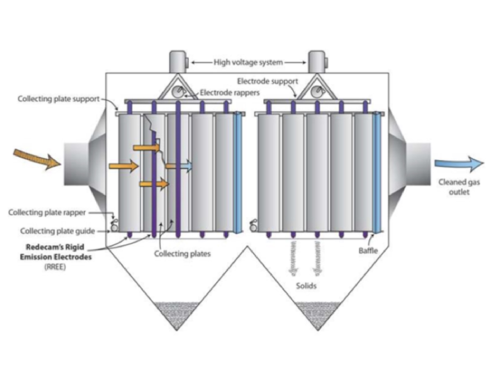Electrostatic Precipitator (ESP)
เครื่องตกตะกอนไฟฟ้าสถิต (ESP), Electrostatic dust collection system it’s a particle collection device and that uses electrostatic forces to remove or separate particles from hot air after combustion. Initially, ESP was used to control fly ash from coal-fired power plants to remove fine particles of unburned minerals. ชุบไฟฟ้าสถิต Electrostatic Precipitator ESP “Which remains suspended in the combustible gas after the combustion of crushed coal principle of electrostatic dust collectors is to give the particles an electric charge in the gas stream but then transmit the particles through an electric field that drives them to the collection electrode. เครื่องดักฝุ่นโรงงาน Finally, the particles are attached to the electrode and collected.
The components of the electrostatic dust collection system include
- Ionize air molecules flowing between electrodes to give or charge the particles.
- Transporting charged particles to the deposition surface.
- Remove the collected particles from the collecting surface.

Types of dust collection systems
1.Plate-Wire Precipitation
2.Flat Plate Precipitation
3.Tubular Precipitation
4.Wet Precipitation
5.Two-stage Precipitation
Working principle of electrostatic dust collector
Gravity Setting Chambers System
Strength
Installation costs, operating costs are very low and are durable.
Weakness
It is large and takes up a lot of space. Low efficiency can only be used with large dust particles.
Cyclone Separator System
Strength
The cost of installation and operation is not high. and can be used with high-temperature dust.
Weakness
The pressure drop is high and cannot be used with dust smaller than 5 microns.
Wet Collector, Scrubber, and Water Spray
Strength
Can remove small dust and if inserting a medium (Filler Media) will be able to trap gas vapor and reduce the temperature of the gas as well.
Weakness
There is a high corrosion problem and need a wastewater treatment system arising from the use of water to trap dust.
Baghouse Filter
Strength
High efficiency in trapping small dust, the dust that can be trapped will be dry dust can be reused.
Weakness
There is no limit to the use of temperature dust and if the dust has moisture, it will cause the bag to become clogged easily.
Electrostatic Precipitator
Strength
High dust treatment efficiency low pressure Can be used with airflow and high temperature.
Weakness
The high electricity bill can not be used with flammable or explosive dust and its use will produce ozone gas which has a corrosive effect.
เครื่องดักฝุ่นโรงงาน Electrostatic dust collector (ESP) is one of the dust collection devices. By relying on electrical force to separate dust from the air.ชุบไฟฟ้าสถิต Electrostatic Precipitator ESP The work consists of negatively charged terminals, also known as Discharge Electrode with dust particles it will run into the island dust-trap (Collecting plate), which has a positive pole and is connected to the ground to act and collect dust. Once the dust has reached a certain thickness (6-12 mm), it will be knocked down into the hopper conveyed from the machine with the following steps.ชุบไฟฟ้าสถิต. เครื่องดักฝุ่นโรงงาน ESP, เครื่องดักฝุ่นโรงงาน ESP
Step 1
The charge of the particles by the discharge electrodes emits electricity. A high voltage (20-110 kV) direct current causes the surrounding air molecules to ionize. And being hit by electrons or negatively charged electrodes, there will be a bright blue light around the pole called the corona. When particles move in, the electric field will be struck by a large number of negative ions of air molecules, causing the particles to have a negative charge.
Step 2
Collecting charged particles using electrostatic forces from electric fields. It is a phenomenon that occurs after a negatively charged particle moves through the electric current. and will be induced to move towards the positively charged pole. and when the particles are sucked towards the particle collection plate, it is called migration-velocity which depends on the voltage acting on particles and traction that occurs as the particles move towards the collection pole In addition when the particles adhere to the collector terminal, the negative charge gradually transfers to the collector terminal. This causes the electric attraction between the particles and the collector terminal to decrease. However, the particle will be released from the collector terminal or will be reversed. of particles generated by the flow of air, currents are relatively small. due to deposition or accumulation of charged particles on the collector terminal In other words, while the particle that binds to the pole has lost most of its charge, the new outer particles that come into the bond will retain an electrical charge, as the charge cannot be transferred through the layer of old particles that have accumulated immediately. Including in the adhesion will cause the bonding force. Between molecules are called Adhesive and Cohesive forces to help to hold all particles in place to the collector terminal. By the process of applying an electric charge to particles and collecting charged particles.
Step 3
Separation of particles from the collector terminal to the spool Separation of particles at the surface of the collector After the accumulation of particles, the collecting electrodes are dislodged. Through knocking or vibration and falling by the gravity of the earth into the hopper below the particles before being disposed of, such as dust, fly ash. or put back into the next process (In case the particles are recycled products such as cement kiln dust, coal, etc.)



